
Dublin Castle is a major Irish government complex, conference centre, and tourist attraction. It is located off Dame Street in central Dublin.

Parliament House in Dublin, Ireland, was home to the Parliament of Ireland, and since 1803 has housed the Bank of Ireland. It was the world's first purpose-built bicameral parliament house. It is located at College Green.
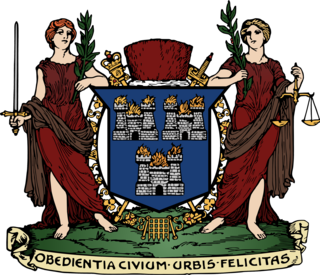
Dublin City Council is the local authority of the city of Dublin in Ireland. As a city council, it is governed by the Local Government Act 2001. Until 2001, the authority was known as Dublin Corporation. The council is responsible for public housing and community, roads and transportation, urban planning and development, amenity and culture and environment. The council has 63 elected members and is the largest local council in Ireland. Elections are held every five years and are by single transferable vote. The head of the council has the honorific title of Lord Mayor. The city administration is headed by a chief executive, Richard Shakespeare. The council meets at City Hall, Dublin.
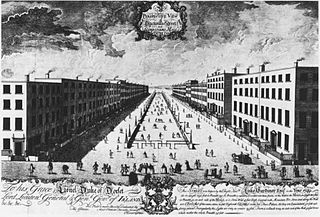
The Wide Streets Commission was established by an Act of Parliament in 1758, at the request of Dublin Corporation, as a body to govern standards on the layout of streets, bridges, buildings and other architectural considerations in Dublin. The commission was abolished by the Dublin Improvement Act of 1849, with the final meeting of the Commission taking place on 2 January 1851.
The architecture of Ireland is one of the most visible features in the Irish countryside – with remains from all eras since the Stone Age abounding. Ireland is famous for its ruined and intact Norman and Anglo-Irish castles, small whitewashed thatched cottages and Georgian urban buildings. What are unaccountably somewhat less famous are the still complete Palladian and Rococo country houses which can be favourably compared to anything similar in northern Europe, and the country's many Gothic and neo-Gothic cathedrals and buildings.

James Gandon was an English architect best known for his work in Ireland during the late 18th century and early 19th century. His better known works include The Custom House and the surrounding Beresford Place, the Four Courts and the King's Inns in Dublin and Emo Court in County Laois.
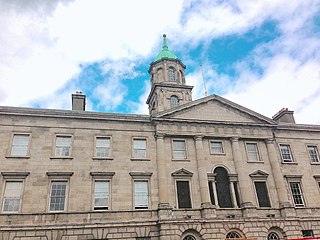
The Rotunda Hospital is a maternity hospital on Parnell Street in Dublin, Ireland, now managed by RCSI Hospitals. The Rotunda entertainment buildings in Parnell Square are no longer part of the hospital complex.

The River Poddle is a river in Dublin, Ireland, a pool of which gave the city its English language name. Boosted by a channel made by the Abbey of St. Thomas à Becket, taking water from the far larger River Dodder, the Poddle was the main source of drinking water for the city for more than 500 years, from the 1240s. The Poddle, which flows wholly within the traditional County Dublin, is one of around a hundred members of the River Liffey system, and one of over 135 watercourses in the county; it has just one significant natural tributary, the Commons Water from Crumlin.

Francis Johnston was an Anglo/Irish architect, best known for building the General Post Office (GPO) on O'Connell Street, Dublin.
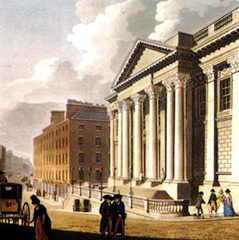
Thomas Cooley (1740–1784) was an English-born Irish architect who came to Dublin from London after winning a competition for the design of Dublin's Royal Exchange in 1768.
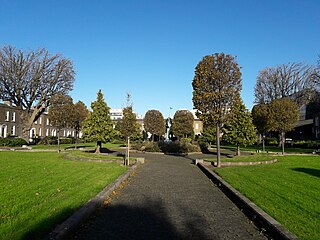
Pearse Square is a Georgian garden square in Dublin, Ireland. It is bounded on its southern side by Pearse Street.
St. Mary del Dam is a former parish church in Dublin, Ireland that for many years occupied an important position in the city, and after which Dame Street is named.

Leixlip is a town in north-east County Kildare, Ireland. Its location on the confluence of the River Liffey and the Rye Water has marked it as a frontier town historically: on the border between the ancient kingdoms of Leinster and Brega, as an outpost of The Pale, and on Kildare's border with County Dublin. Leixlip was also a civil parish in the ancient barony of Salt North.

Daly's Club, with premises known as Daly's Club House, was a gentlemen's club in Dublin, Ireland, a centre of social and political life between its origins in about 1750 and its end in 1823.

The Tholsel was an important building in Dublin, Ireland which combined the function of civic hall, guildhall, court, gaol and even for a period acted as parliament house from 1641-48.
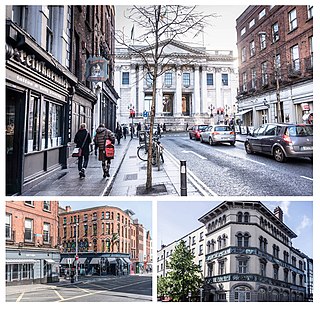
Parliament Street is a street located on Dublin's Southside. It runs from the junction of Dame Street and Cork Hill on its southern end to the junction of Essex Quay and Wellington Quay on its northern end where it joins directly onto Grattan Bridge and subsequently Capel Street.

Crampton Court, also colloquially known as Love Lane since the mid-2010s, is a short lane or passageway located in Temple Bar in central Dublin, Ireland. A small open-air square exists at approximately the halfway point of the lane, measuring approximately 11.5 by 16.7 metres wide, from which narrow, semi-covered lanes lead to its northern and southern entrances.
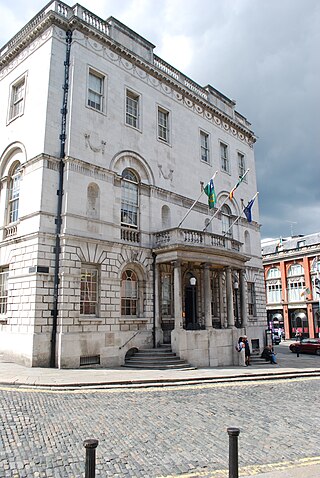
Newcomen Bank is a former Georgian bank building and private residence on the junction of Cork Hill, Lord Edward Street and Castle Street, designed by architect Thomas Ivory in 1781 with the assistance of James Hoban.






























